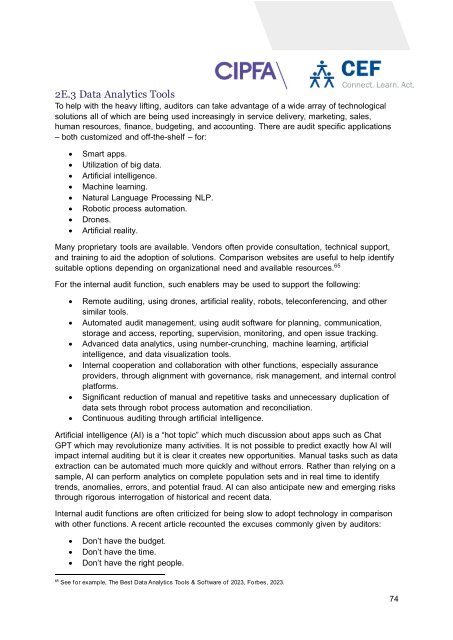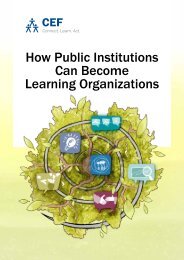TIAPS ALB_Module 2E. Data Analytics for Internal Auditing
- No tags were found...
Create successful ePaper yourself
Turn your PDF publications into a flip-book with our unique Google optimized e-Paper software.
<strong>2E</strong>.3 <strong>Data</strong> <strong>Analytics</strong> Tools<br />
To help with the heavy lifting, auditors can take advantage of a wide array of technological<br />
solutions all of which are being used increasingly in service delivery, marketing, sales,<br />
human resources, finance, budgeting, and accounting. There are audit specific applications<br />
– both customized and off-the-shelf – <strong>for</strong>:<br />
• Smart apps.<br />
• Utilization of big data.<br />
• Artificial intelligence.<br />
• Machine learning.<br />
• Natural Language Processing NLP.<br />
• Robotic process automation.<br />
• Drones.<br />
• Artificial reality.<br />
Many proprietary tools are available. Vendors often provide consultation, technical support,<br />
and training to aid the adoption of solutions. Comparison websites are useful to help identify<br />
suitable options depending on organizational need and available resources. 65<br />
For the internal audit function, such enablers may be used to support the following:<br />
• Remote auditing, using drones, artificial reality, robots, teleconferencing, and other<br />
similar tools.<br />
• Automated audit management, using audit software <strong>for</strong> planning, communication,<br />
storage and access, reporting, supervision, monitoring, and open issue tracking.<br />
• Advanced data analytics, using number-crunching, machine learning, artificial<br />
intelligence, and data visualization tools.<br />
• <strong>Internal</strong> cooperation and collaboration with other functions, especially assurance<br />
providers, through alignment with governance, risk management, and internal control<br />
plat<strong>for</strong>ms.<br />
• Significant reduction of manual and repetitive tasks and unnecessary duplication of<br />
data sets through robot process automation and reconciliation.<br />
• Continuous auditing through artificial intelligence.<br />
Artificial intelligence (AI) is a “hot topic” which much discussion about apps such as Chat<br />
GPT which may revolutionize many activities. It is not possible to predict exactly how AI will<br />
impact internal auditing but it is clear it creates new opportunities. Manual tasks such as data<br />
extraction can be automated much more quickly and without errors. Rather than relying on a<br />
sample, AI can per<strong>for</strong>m analytics on complete population sets and in real time to identify<br />
trends, anomalies, errors, and potential fraud. AI can also anticipate new and emerging risks<br />
through rigorous interrogation of historical and recent data.<br />
<strong>Internal</strong> audit functions are often criticized <strong>for</strong> being slow to adopt technology in comparison<br />
with other functions. A recent article recounted the excuses commonly given by auditors:<br />
• Don’t have the budget.<br />
• Don’t have the time.<br />
• Don’t have the right people.<br />
65<br />
See <strong>for</strong> example, The Best <strong>Data</strong> <strong>Analytics</strong> Tools & Software of 2023, Forbes, 2023.<br />
74
















